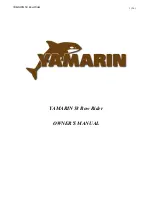
47
it worth while installing, if you have not already done so, a manual water system. The manual
system requires hand or foot pumping, and it invariably results in better water conservation.
2. Bilge Pumps
The Tayana 42 is equipped with two bilge pumps – one electrical and one hand operated. Both
of these pumps should be checked every day that the yacht is sailed. The electrical bilge pump is
by PAR and is located in the same compartment as the fresh water pump. The intake hose goes
down past the engine and into the bilge sump below the engine. The pump outlet is just above the
water line on the side of the yacht. The most common failure is a dirty pick-up screen. This may
be cleaned simply by pulling the intake hose up from the sump and removing the dirt. A few
failures because of dirt in the bilge will probably result in a greater effort to keep the bilges clean
and sweet. There may be an in-line filter close to the pump that should also be cleaned. The hand
bilge pump is generally located in the cockpit. The hand bilge pump serves two purposes – it
pumps the bilge and it pumps the holding tank. By following the intake line from the pump, one
will come to a set of two valves. With one valve closed and the other open, you can see that the
pump clears the bilge. By reversing the closure of the valves the pump clears the holding tank. A
little experimenting will show you the proper valve operation.
NOTE
: A second electric bilge pump is a wise addition.
3. Holding Tank
Your 42 has a holding tank system which is legal anywhere. The toilet may be pumped either
into the holding tank or overboard directly. The waste holding tank is a 35-gallon fiberglass tank
located beneath the cabin sole in the vicinity of the head. The 1 ½ inch outlet hose from the tank
tees to the deck pump-out fitting, and the manual bilge pump is located in the cockpit. A valve
beneath the cockpit switches the intake to the manual bilge pump from the bilge water to the
holding tank. A small diameter vent hose leads to an outlet on the port side of the hull just below
the toe rail. This vent line must be open (not clogged) in order to pump waste into, or out of, the
tank. An 8 inch port in the top of the tank provides access should you need to work on the tank
(e.g., to replace the stainless steel outlet fitting). When winterizing the holding tank, after
pumping out the waste, pump ethylene glycol antifreeze (not the pink or blue propylene glycol
antifreeze, as this type of antifreeze can damage the flexible valves and seal in the head) into the
tank through the head.
Содержание VANCOUVER 42
Страница 1: ...1 OPERATIONS AND MAINTENANCE MANUAL TAYANA VANCOUVER 42...
Страница 2: ...2 Tayana V 42 Center Cockpit Sailplan...
Страница 3: ...3 Tayana V 42 Aft Cockpit Interior Layout...
Страница 12: ...12 Figure II 1 Fiberglass Layout Schedule...
Страница 13: ...13 Figure II 2 V 42 Deck and Hull Joint...
Страница 19: ......
Страница 37: ...37 Figure IV 1 Fuel Supply Plumbing...
Страница 38: ...38 Figure IV 2 Fluid Plumbing System...
Страница 39: ...39 Figure IV 3 Center Cockpit Tankage Diagram...
Страница 43: ...43 TABLE IV 1 Direct Current Energy Audit...
Страница 48: ...48 Figure IV 6 Waste Water Plumbing System...
Страница 51: ...51 Figure IV 8 Propane System...
















































